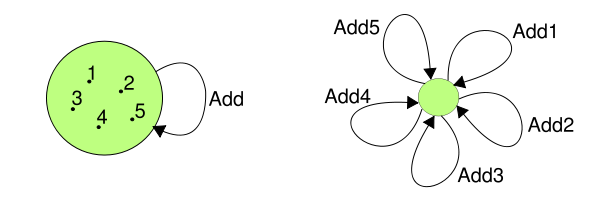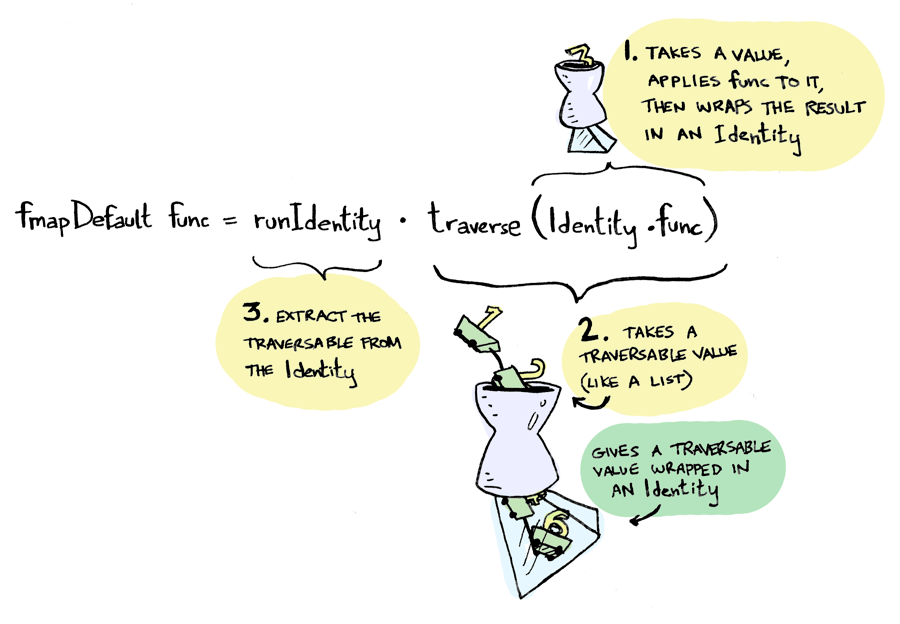Monoid(幺半群)
Monoid是一个数学上的概念:
幺半群是一个存在单位元
(幺元
)的半群
即,考虑定义了二元运算 ∘ : S -> S(注意这里蕴含了S对运算∘ : S -> S封闭)的非空集合S,若满足如下公理:
结合律:∀ a, b, c∈ S,有 (a∘b)∘c = a∘(b∘c)
单位元:∃ e∈S ,使∀ a∈ S,有 a∘e = e∘a
则三元组<S, ∘, e>称为幺半群。
看到结合律有没有勾起童年的回忆?就是小学数学的加法结合律:
1
2
|
(5 + 6) + 10 -- 21
5 + (6 + 10) -- 21
|
有了结合律,还需要一个幺元,所有数和它进行运算(相加)都等于自身,很明显就是0。
1
2
|
255 + 0 -- 255
0 + 255 -- 255
|
当然乘法也有结合律,这时幺元就是1了。
不止数值,还有很多其他的类型也可以满足这些条件,比如List和String:
1
2
3
4
|
([1,2,3] ++ [4,5,6]) ++ [7,8,9] -- [1,2,3,4,5,6,7,8,9]
[1,2,3] ++ ([4,5,6] ++ [7,8,9]) -- [1,2,3,4,5,6,7,8,9]
[1,2,3] ++ [] -- [1,2,3]
[] ++ [1,2,3] -- [1,2,3]
|
在编程领域中,Monoid是这样定义的:
1
2
3
4
5
6
|
class Monoid a where
mempty :: a
mappend :: a -> a -> a
mconcat :: [a] -> a
mconcat = foldr mappend mempty
|
我们可以把mempty当作幺元,把mappend当作那个二元运算。mconcat就是遍历一个List然后把其中的元素用mappend连起来最后组成单个元素(第一个元素和幺元进行运算):
1
|
mconcat ["Tree", "fingers"] -- "Treefingers"
|
还有我们经常用的reduce函数本质上就是做了这个:
Elixir
1
2
3
|
Enum.reduce [1, 2, 3], &+/2 # 6
# 等价于
Enum.reduce [1, 2, 3], 0, fn x, acc -> x + acc end
|
Javascript
1
2
3
4
|
const array = [1, 2, 3]
const reducer = (accumulator, currentValue) => accumulator + currentValue
// 1 + 2 + 3
console.log(array.reduce(reducer))
|
完整性起见,这里把Monoid需要满足的laws写在这,其实就是对应了数学定义:
1
2
3
|
(x <> y) <> z = x <> (y <> z) -- associativity
mempty <> x = x -- left identity
x <> mempty = x -- right identity
|
Foldable
在上边的Monoid中,我们看到了mconcat的实现,它用了foldr这个函数,foldr是个很有用的函数,被用在很多地方,它的类型是这样的:
1
|
foldr :: (a -> b -> b) -> b -> [a] -> b
|
首先我们要提供一个函数f :: (a -> b -> b),然后给一个初始的b和一个 [a](List a),foldr会遍历[a]并利用函数f最终生成一个b(注意这里的a,b是类型变量)。
有了foldr就可以实现Foldable,Foldable的定义如下:
1
2
3
4
5
6
7
8
9
10
11
12
13
14
15
16
17
18
19
20
|
-- Abridged definition, with just the method signatures.
class Foldable t where
foldMap :: Monoid m => (a -> m) -> t a -> m
foldr :: (a -> b -> b) -> b -> t a -> b
-- All of the following have default implementations:
fold :: Monoid m => t m -> m -- generalised mconcat
foldr' :: (a -> b -> b) -> b -> t a -> b
foldl :: (b -> a -> b) -> b -> t a -> b
foldl' :: (b -> a -> b) -> b -> t a -> b
foldr1 :: (a -> a -> a) -> t a -> a
foldl1 :: (a -> a -> a) -> t a -> a
toList :: t a -> [a]
null :: t a -> Bool
length :: t a -> Int
elem :: Eq a => a -> t a -> Bool
maximum :: Ord a => t a -> a
minimum :: Ord a => t a -> a
sum :: Num a => t a -> a
product :: Num a => t a -> a
|
Foldable的函数有很多,但是在实现的时候只需要实现flodMap或者foldr其中一个就可以了,其他的函数都可以用这两个函数间接实现。
Foldable和Functor都是遍历List,回顾一下Functor:
1
2
3
|
instance Functor [] where
fmap _ [] = []
fmap f (x:xs) = f x : fmap f xs
|
fmap f遍历一遍列表,将f应用到每个元素上,生成一个新的列表。类似地,foldMap f也遍历列表,将f应用于每个元素,不同之处是flodMap会利用mappend将结果组合起来。然而有一种遍历是fmap和flodMap都无法做到的,设想我们有这样一个函数:
1
2
|
deleteIfNegative :: (Num a, Ord a) => a -> Maybe a
deleteIfNegative x = if x < 0 then Nothing else Just x
|
deleteIfNegative接收一个数值,如果是负数则返回Nothing,如果不是负数则返回Just x ,也就是说deleteIfNegative的返回值是一个Maybe 类型。
然后我们想利用它实现下边的函数:
1
|
rejectWithNegatives :: (Num a, Ord a) => [a] -> Maybe [a]
|
rejectWithNegatives接收一个[a],如果List里有负数则返回Nothing,如果都不是负数则返回Just [a],这时候如果使用fmap:
1
2
3
|
GHCi> let testList = [-5,3,2,-1,0]
GHCi> fmap deleteIfNegative testList
[Nothing,Just 3,Just 2,Nothing,Just 0]
|
不太行,正如之前所说,fmap就是把f作用列表上,返回的是[Maybe a];而flodMap也不行,虽然它会把经过f处理过的元素组合起来,这时我们需要的是Traversable。
Traversable
先来看一下定义:
1
2
3
4
5
6
7
8
|
class (Functor t, Foldable t) => Traversable t where
traverse :: Applicative f => (a -> f b) -> t a -> f (t b)
sequenceA :: Applicative f => t (f a) -> f (t a)
-- These methods have default definitions.
-- They are merely specialised versions of the other two.
mapM :: Monad m => (a -> m b) -> t a -> m (t b)
sequence :: Monad m => t (m a) -> m (t a)
|
traverse和sequenceA也可以互相实现,所以我们只需要实现一个就可以,剩下的函数都可以用这两个函数定义出来:
1
2
|
traverse f = sequenceA . fmap f
sequenceA = traverse id
|
来看看用Traversable怎么解决实现rejectWithNegatives的问题,首先我们要对List实现Traversable:
1
2
3
4
5
6
7
8
|
instance Traversable [] where
-- sequenceA :: Applicative f => [f a] -> f [a]
sequenceA [] = pure []
sequenceA (u:us) = (:) <$> u <*> sequenceA us
-- 等同于:
instance Traversable [] where
sequenceA us = foldr (\u v -> (:) <$> u <*> v) (pure []) us
|
有了Traversable,我们就可以实现rejectWithNegatives了:
1
2
3
4
5
6
7
|
GHCi> let rejectWithNegatives = sequenceA . fmap deleteIfNegative
GHCi> :t rejectWithNegatives
rejectWithNegatives :: (Num a, Ord a, Traversable t) => t a -> Maybe (t a)
GHCi> rejectWithNegatives testList
Nothing
GHCi> rejectWithNegatives [0..10]
Just [0,1,2,3,4,5,6,7,8,9,10]
|
当然我们可以用traverse函数来实现:
1
2
|
rejectWithNegatives :: (Num a, Ord a, Traversable t) => t a -> Maybe (t a)
rejectWithNegatives = traverse deleteIfNegative
|
traverse的类型是 (a -> f b) -> t a -> f (t b),而deleteIfNegative的类型是a -> Maybe a,所以traverse deleteIfNegative 的类型正好是 t a -> Maybe (t a)。
照例写一下Traversable的laws:
1
2
3
4
|
-- identity law
traverse Identity = Identity
-- composition law
traverse (Compose . fmap g . f) = Compose . fmap (traverse g) . traverse f
|
有了Traversable之后,List的遍历操作就相对完整了。
我们再来看一下traverse做了什么:
1
|
traverse :: (Traversable t, Applicative f) => (a -> f b) -> t a -> f (t b)
|
单看这个类型,可以感觉出来它和fmap :: (a -> b) -> f a -> f b冥冥中貌似有些联系,其实我们是可以用traverse来实现fmap的,traverse比fmap多了些东西,也就是f,如果我们能把traverse中的f去掉就会得到一个fmap了:(a -> b) -> t a -> t b。而这里的f是一个Applicative,我们需要找到一个Applicative达到“去掉自己”的目的,去掉自己其实就是说这个Applicative没有任何操作,只是为了达到Applicative要求的一个容器,而这正是Identity做的事:
1
2
3
4
5
6
7
8
9
10
11
12
|
newtype Identity a = Identity { runIdentity :: a }
instance Functor Identity where
fmap f (Identity x) = Identity (f x)
instance Applicative Identity where
pure = Identity
Identity f <*> Identity x = Identity (f x)
instance Monad Identity where
return = pure
Identity x >>= f = f x
|
Identity我们可以理解成一个只有Just的Maybe类型,什么都不做,就是封装一下数据,想拿出来就拿出来,我们可以利用它实现traverse到fmap的转换:
1
2
|
fmapDefault :: Traversable t => (a -> b) -> t a -> t b
fmapDefault f = runIdentity . traverse (Identity . f)
|
它的工作原理是这样的:
如果我们一步一步地看各个步骤的类型,就会是这样的:
1
2
3
4
5
|
-- f :: a -> b
-- Identity . f :: a -> Identity b
-- traverse :: (a -> Identity b) -> t a -> Identity (t b)
-- traverse (Identity . f) :: t a -> Identity (t b)
-- runIdentity . traverse (Identity . f) :: t a -> t b
|
Conclusion
到此为止我们已经熟悉了Functor, Applicative, Monad, Foldable和Traversable这五种type classes,有了这些武器就可以继续了解更多函数式编程中的概念了。上边那个traverse转换成fmap的过程是很有趣的,它正是理解lens的基础,关于lens我们在之后的文章再分解。

